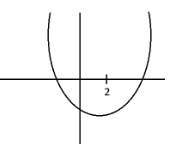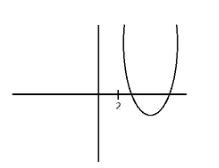Question
Question: \({{x}^{2}}-\left( m-3 \right)x+m=0\left( m\in R \right)\) be a quadratic equation. Find the value o...
x2−(m−3)x+m=0(m∈R) be a quadratic equation. Find the value of m for which, at least one root is greater than 2.
A. [−9,9]
B. [9,∞)
C. (−∞,9]
D. None of the above.
Solution
Hint: We will use the concepts of quadratic functions to solve the problem. We will be using the fact that if both roots exist then the discriminant of the quadratic function is always greater than zero we will form another inequality by using the fact that we have given that one root is greater than 2 then we will use these two inequalities to find the range of m.
Complete step-by-step answer:
Now, we have to find the m for which f(x)=x2−(m−3)x+m has at least one root greater than 2. Now, here two cases arise. In the first case we have a number of greater than 2 is one. So, graph of this case is,

Now, from the graph we can see that D≥0and f(e)<0.
Now, solving D≥0for f(x)=x2−(m−3)x+m.
(m−3)2−4m≥0m2+9−6m−4m≥0m2−10m+9>0m2−9m−m+9≥0m(m−9)−1(m−9)≥0(m−1)(m−9)≥0
Now for −∞<x≤1 and 9<x<∞we have (m−1)(m−9)≥0.
So,
x∈(−∞,1]∪[9,∞)...........(1)
Also, f(2)<0 . So,
4−(m−3)2+m<04−2m−6+m<010<mm>10.............(2)
Combining (1) & (2) we get;
x∈(10,∞) for case 1;
We will similarly solve for case 2 in which both roots are greater than 2. So, graph of this case is,

Now, from graph we have
D≥0 and f(2)≥0
D≥0is same as equation (1)
So, for f(2)≥0we have;
4−(m−3)2+m≥04−2m+6+m≥010≥mm≤10..............(3)
Now, combining (1) and (3) we have;
x∈(−∞,1]∪[9,10]...................(4)
Now, we will be taking a union of solutions of both cases as both of them satisfy the given condition.
So,
x∈(−∞,1]∪[9,10]∪(10,∞)x∈(−∞,1]∪[9,∞)
Option (B) is the correct option as it is the only correct subset of the solution.
Note: To solve these type of questions it is important to note that we have used the fact that if both roots of the quadratic equation are real and distinct then the discriminant of the quadratic equation is greater than zero also it has to be noticed that we have divided the question in cases and then solved for each cases for the condition that one root is greater than zero.
